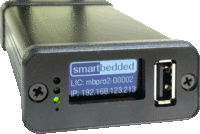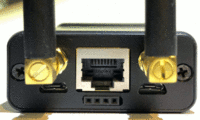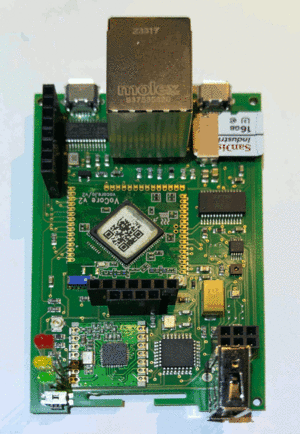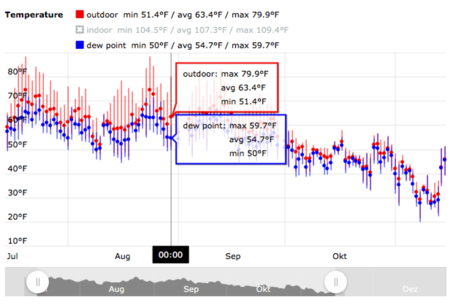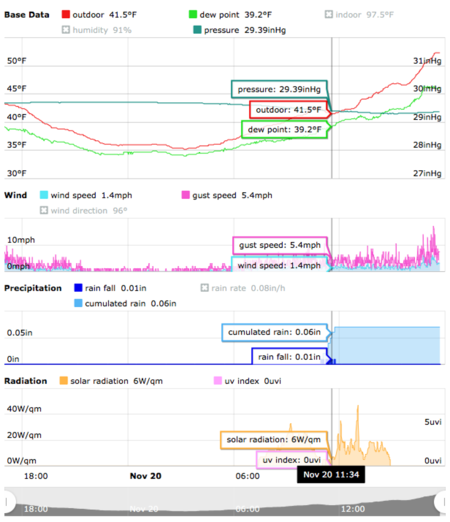Meteobridge PRO2
Contents
The Next Gen Meteobridge PRO
As Meteobridge PRO was launched in 2015 time has come to present an improved successor. We are happy to announce that the PRO2 is now ready for prime time. The success of the Meteobridge PRO over the last years motivated us to keep its basic strengths and to selectively improve capabilities. Top priority was to keep its low energy profile to make it a really carbon footprint friendly device for weather data storage, aggregation, analysis, graphing and publication.Exteriour
The exterior dimensions of the PRO2 are unchanged compared to the PRO. To distinguish it from previous model, the housing is now completely black. Front panel has the same structure as before. You have a reset hole, LEDs for power, status and RF reception, an OLED display and a full size USB2 port. As OLEDs show wear after years of operation, the OLED can now be exchanged more easily and without soldering. Back panel comes with an WLAN and a RF antenna, a micro USB power connecter, an additional micro USB port, an Ethernet socket and a 4-pin I2C port for future expansions (like an I2C temperature/humidity probe that does not breath the warm climate in the PRO2 housing). Beside the I2C there is not much difference compared to the PRO from the outside.Inner Values
Better CPU
Meteobridge PRO2 is no longer driven by the Carambola2 SOC but by the VoCore2 SOC that had its premiere at the Meteobridge NANO. This SOC upgrade gives the PRO2 about 30% more processing punch, reduces power consumption down to an average of 1.5 Watts (regardless WLAN or LAN operation). While the Meteobridge PRO did heat up noticeably over time, the PRO2 remains hand warm and does not feel hot at all. The VoCore2 provides double the RAM of the Carambola2 which gives the PRO2 more headroom when running code. As an effect the PHP-based dashboards introduced for Meteobridge NANO SD are now also available on the PRO2.
Better Internal Sensors
The PRO2 has an improved internal temperature/humidity sensor (SHT31) and a better barometric sensor (BMP390) compared to the Meteobridge PRO. The external accessibility of the I2C bus that drives internal sensors also allows easy and cheap connection of an I2C external sensor to get true indoor temperature, not affected by warm climate inside the PRO2 enclosure.
Better Data Storage
The previous model stored data on a 1 GB industrial SLC USB stick. That was a proper solution for that time, but USB sticks draw more power than SD cards, are in general slower and are rather bulky. Meteobridge PRO2 switches to an 16 GB industrial SLC micro SD card, so we get much more room for data, which allows to store per minute sensor data for a decade or more, with a much smaller footprint as before.
Better Display Exchange
As OLED displays are very crisp and bright they are suffering from wear. After a year of display usage these wear marks will start showing up. To allow for a cheap and easy display exchange it is no longer soldered but put on a socket. That allows the technical experienced user to exchange the display himself. We would prefer to use displays that do not suffer from wear, but currently the OLEDs suitable for a Meteobridge cannot provide this.
Better Operating System
Meteobridge PRO2 comes with OpenWRT 21.02.3 and by that solves a lot of SSL related issues with the previous model. SFTP and SSH issues can now take a rest. Furthermore WPA3 and up to date SMB protocols are supported.
Better Add-On Options
By placing all needed parts on the base board, Meteobridge PRO can host an additional board to integrate new features. The additional board will be provided with power, USB, and a serial connection from the base board. Having this upgrade path make the PRO2 even more future ready. It is obvious that we are currently thinking about 4G/LTE modules or NBIoT modules as add-on boards, but please don't take this as an announcement, it is just sharing obvious thoughts.
Future Options
The I2C connector at the back is not the only change to allow for HW addons for the PRO2. The PCB redesign mad it passible to get rid of the separated RF board of the previous model. While the Meteobridge PRO had the main stuff on the base board there was a second board responsible for providing the data storage in terms of an internal USB stick and the RF reception circuitry. The PRO2 has all components (micro SD card for data storage, RF circuitry) on the base board, which gives the option to design a daughter board that can be connected by
- a tiny shape
- keep low power foot print and find ways to monitor power use
- keep size real tiny
- get rid of necessary USB hubs
- add permanent storage for local data persistence
- integrate RF features to directly readout data from Davis sensors
- equip with proper RF and WiFi antenna
- allow direct GPRS/3G operation with a optional standard USB mobile dongle
- add a database for permanent storage of data
- allow flexible data exports, where data can be picked up from SMB share or sent via mail of FTP
- have some sensors in the box itself (pressure, temp, hum)
- some kind of status and data display would be great
- sensor data graphing features out of the box would be great
After a quite some months of prototyping and new HW/SW design we are going to release this unique new bundle of dedicated hardware and advanced Meteobridge software as the new Meteobridge PRO.
You can find a datasheet about the Meteobridge PRO here, which summarizes the key features on three pages.
Meteobridge PRO can graph weather data in a very versatile way and can feed those graphs to your web server to be integrated into your web presence. You can see some of the predefined examples on the right.
Units hit the markets in January 2016. There are two versions, one with the Vantage RF receiving capabilities and the shiny red caps, see picture) and one without (which will have black caps). Units always come fully licensed, license transfer from standard Meteobridges is not planned.
The introduction of the PRO will not stop further development of the standard Meteobridge. They share 90% of the code and will be both further developed, of course with the PRO offering much more options.
Where to Buy?
Meteobridge PRO is available from these resellers as a turn-key solution (including license, power supply, Ethernet cable, USB converter cabel):
- AmbientWeather located in the US sells Meteobridge PRO with RF module as "WeatherBridge PRO". Please visit their online shop to checkout options and prices.
- meteo.cc located in Switzerland sells Meteobridge PRO with (red) and without (red) RF module as "weatherBoxx PRO". Please visit their online shop to checkout options and prices.
- Prodata Weather Systems located in the UK sells Meteobridge PRO with and without RF module. Please visit their website to check out options and prices.
- Weerhuisje located in the Netherlands sells Meteobridge PRO with and without RF module. Please visit their website to check out prices and options.
- soluzionimeteo.it located in Italy sells Meteobridge PRO with and without RF module. Please visit their website to check out prices and options.
- weerspecialist.nl located in the Netherlands sells Meteobridge PRO with and without RF module. Please visit their online shop to check out options and prices.
- meteobridge.shop is offering Meteobridge PRO with and without RF module. Please visit their online shop to checkout options and prices.
